Psycho Cowboys Part I
We’re all familiar with the usual suspects when it comes to back-shooting murderin’ dry-gulch killers such as Lee Marvin and Bruce Dern as featured in the Westerns of John Wayne.
I thought maybe we’d wander off the reservation a spell and track down some of the most seriously psychotic screen cowboys who operated outside of JW films and list them in order of the most despicable.
You know the type. The murderous skunk the audience prays with all their might is going to get what’s coming to them at the end and then let’s out a whoop of “Now that’s what I’m talkin’ about” when the miscreant finally meets their maker, preferably in the most violent manner possible.
Unlike the plethora of likeable villains one encounters throughout the Western genre such as Eli Wallach’s Tuco in “The Good the Bad and the Ugly” or Richards Widmark as Clint Hollister in “The Law and Jake Wade”, the following characters have absolutely no redeeming features whatsoever.
Michael Gambon – “Open Range”
As played by British actor Michael Gambon, landowner Baxter is a take-no-prisoners loud-mouthed bully who ruthlessly lords it over the townsfolk of Harmonsville.
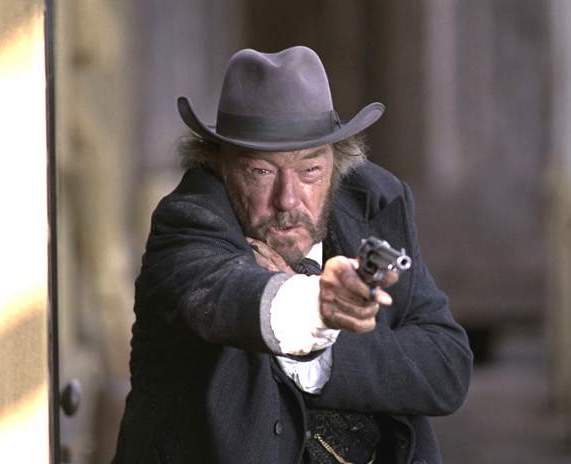
Determined not to let any wandering cowboy open rangers feed their herds on his land Baxter has his corrupt sheriff beat up Mose Harrison (Abraham Benrubi) who has been sent by trail herder Boss Spearman (Robert Duval) to pick up some supplies.
It is this action that eventually seals Baxter’s fate but not before he has Mose murdered, his friend Button (Diego Luna) beaten almost to death, as well as threatening the whole town if they try and get in his way.
When the final showdown comes to pass it’s up to Boss and his companion Charlie Waite (Kevin Costner) to take on Baxter and his boys, Charlie initiating the proceedings by getting up close and personal and shooting one of Baxter’s hired guns in the forehead.
It goes without saying that when confronted by forces prepared to stand up to them most bullies turn tail and run to the hills. In this case, a wounded Baxter, having seen his thugs killed after the townsfolk finally call time on him, ends up hiding in the jailhouse where Boss confronts him.
Shot full of holes and defiant to the end Baxter utters his last words, “You’re nuthin”, to which Boss replies “Maybe so but I’ll still be breathin’ in another minute”
Amen to that.
Dan Duryea – Winchester 73
Described variously as a “sneering cold-blooded villain”, “conniving” and, in the words of the actor himself, “the meanest s.o.b. in the movies”, Duryea lived up to all three descriptions as the nasty killer “Waco Johnny” Dean in the Anthony Mann classic Western “Winchester 73”.
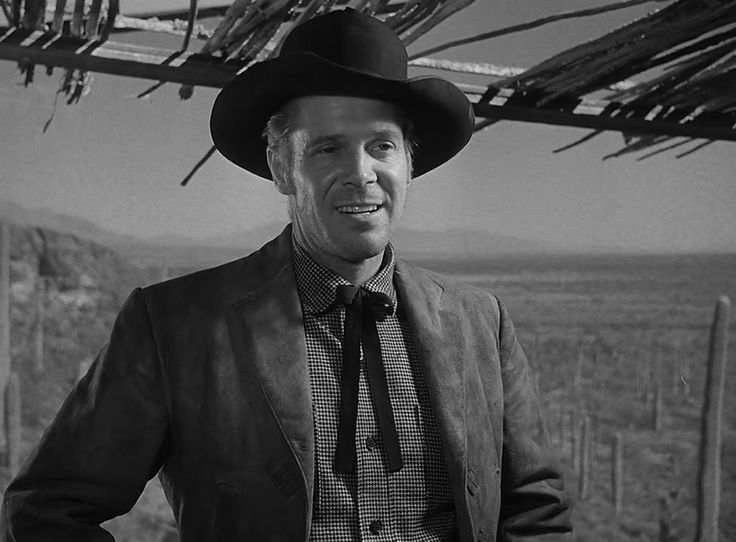
Coveting the rifle that has fallen into the hands of the cowardly Steve Miller (Charles Drake), Waco, “the lowest thing standing in a pair of boots”, goads Miller into drawing his gun and then plugs the sap, taking the weapon for his own.
Later on, he is forced to give it up to Dutch Brown (Stephen McNally), who in turn had already stolen it from the rightful owner, his brother Lin (James Stewart).
When confronting Waco in a saloon as to the whereabouts of his brother, Lin momentarily proves to be just as sadistic and deranged as his opponent.
In a scene that apparently drew gasps of astonishment from audiences at the time, he nearly breaks Waco’s arm, clawing at his face as he tries to get him to inform on where Dutch is.
Waco offers to lead the way then foolishly turns to shoot but Lin beats him to the draw. Waco ends face down in the dirt where we always knew he belonged.
Ben Foster – “3:10 to Yuma”
Described by a fellow film critic elsewhere as a “psychobilly space cowboy”, Ben Foster as killer Charley Prince almost steals the show from both Russell Crowe as Ben Wade and Christian Bale as Dan Evans in this 2007 remake of the classic Delmer Daves Western.
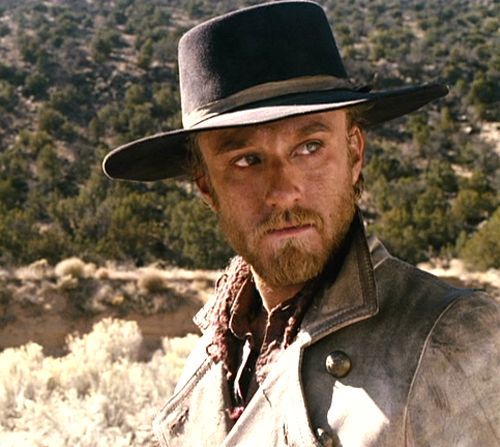
Only a few minutes into the film he murders two Pinkerton men and gut shoots that nice Peter Fonda. At the halfway point he ups the sadism count to eleven and burns a man alive who has become trapped in a stagecoach.
Foster’s green eyes blaze murderously from the screen in a performance that gives Henry Fonda in “Once Upon A Time in the West” a real run for the money, the actor adding an extra layer of sociopathy by hardly ever blinking.
Taking a rather more brutal turn than the ending of the original, in a “whoa I didn’t see that coming” moment, Prince shoots Evans in the back, finishing him off with another three shots just to make sure he’s done the job properly.
Mistakenly thinking that Wade, who had been taken prisoner by Evans, would be happy with this, the killer hands a gun to his boss who blows away all the other members of his gang then delivers a final coup de grace to Prince by shooting him in the chest at point blank range.
Never was a screen death so richly deserved, although the next killer on the list might just as easily qualify.
Lee Van Cleef – “The Good the Bad and the Ugly”
It was obvious to cinemagoers back in the early 1950s that when seeing a mean-looking Lee Van Cleef for the first time on screen in “High Noon” as silent gunslinger Jack Colby that this was definitely someone you would not want to bump into in a dark alley.
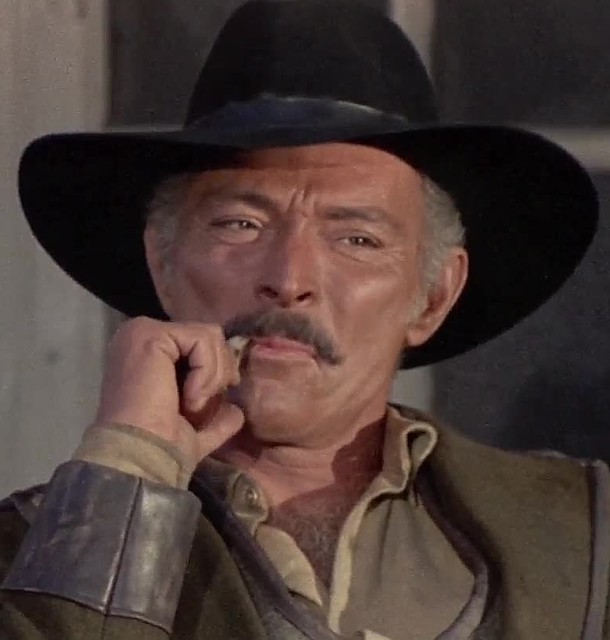
Mainly playing the villain, including a small part in “The Man Who Shot Liberty Valance”, Cleef’s career finally took off in the mid-1960s after his role as Douglas Mortimer in “For Few Dollars More”, featuring one of his more sociable performances.
Thankfully for the purpose of this article, he reverted to type in “The Good the Bad and the Ugly” as hired killer ‘Angel Eyes’. We first meet him dropping in for a chat with a man called Stevens who Angel has been hired to kill.
Stevens tries to buy him off with a thousand dollars, suggesting he takes the money and kills the man who sent him. When Stevens realises he’s a goner he pulls his gun only to be beaten to the draw, Angel offing an armed youngster seconds later.
Angel then seeks out his employer, a man called Baker who had offered to pay Angel five hundred dollars to kill Stevens. Angel takes his money then informs Baker that Stevens paid him a thousand to kill him instead, stating that he always sees a job through to the end.
Placing a pillow over the screaming man’s face Angel pumps four bullets into him, giving the audience a trademark chuckle as the words ‘the bad’ flash up on the screen in blood red.
Angel then gets to beat Tuco (Eli Wallach) almost to death before the final showdown between him, Tuco and Blondie (Clint Eastwood) at Sad Hill Cemetery.
Blondie takes him out first, shooting Angel dead then propelling his hat and gun into the open grave Angel now occupies. If I have one complaint about Cleef’s death scene it’s that he dies too quickly.
It would have been better to have strung it out a bit more and made him suffer, just as Angel does with his own victims. Still, dead is dead I guess.
Gene Hackman – Unforgiven
I know I stated at the beginning of this article that no character featured so far has any redeeming features whatsoever, which is why Hackman’s vivid portrayal of the no-nonsense sheriff “Little Bill” Daggett nearly didn’t make it onto the list.
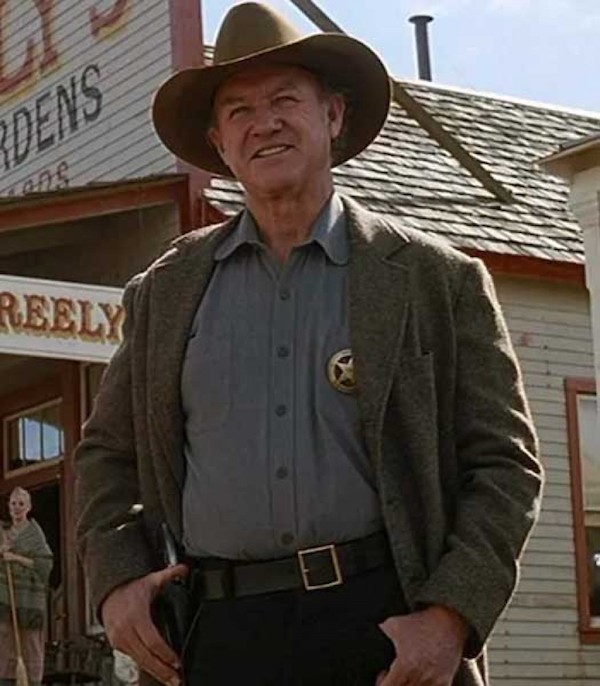
This is mainly because somewhere in his black heart all Daggett wanted was to build himself a house and eventually live a normal life, which is hardly the act of a psychotic killer.
Unfortunately, his sadistic behaviour toward those less inclined to cherish domesticity felt otherwise, which is why at the end his fate is sealed by gunfighter William Munny (Clint Eastwood), whose philosophy in life is encapsulated in the phrase “We all got it comin’, kid”.
Munny, Ned Logan (Morgan Freeman) and a young pretender by the name of the Schofield Kid, team up and ride off to the town of Big Whiskey in order to kill two men who scarred a lady of the night and get themselves some much-needed cash in the process.
Unfortunately, Little Bill discourages anyone wanting to claim the reward, despatching notorious gunfighter English Bob (Richard Harris) by kicking the crap out of him so hard Bob ends up speaking like a Cockney.
He also hands out the same treatment to Munny but whereas Bob wisely takes the next boat back to Blighty, Munny is made of sterner stuff.
Things eventually come to a head when Daggett murders Munny’s friend Ned, whom Daggett whips, tortures to death and then displays his corpse in the window of the local saloon.
Munny exacts revenge by shooting the unarmed proprietor of the establishment after which he states to an outraged Little Bill that “he should have armed himself if he’s going to decorate his saloon with my friend”.
Munny then proceeds to slaughter anything that crawls or moves in the saloon, wounding the sheriff in the process. He reloads his shotgun, points it at Little Bill’s head then, after a brief exchange about seeing each other in hell, Munny pulls the trigger and shoots Daggett in the face.
To this day I still clearly remember watching that scene the first time and being completely caught out when Munny kills Daggett. I honestly didn’t believe he was going to murder someone in cold blood but then of course that’s exactly what he would do. He’s a professional killer after all.
The question that needs to be asked of course is, who is the real psycho cowboy here? Munny or Little Bill. I’m going for Daggett on account he seems to enjoy what he does whilst Munny expresses regret for his past, haunted as he is by nightmares of the people he’s murdered over the years.
It’s a close call though.
Killer Cowboys Part 2
Welcome to part 2 of our roundup of killer cowboys, all with one thing in common. We cheered to the rafters when their time was up. On with the show.
Richard Boone – “The Tall T”
Goodness. Now, where do we start with this guy?
I was initially intent on singling out Boone’s portrayal of the outlaw Grimes in “Hombre”, specifically a scene in which he scares a stagecoach passenger into handing his ticket over, emasculating the poor man in the process.

No guns or shooting, just a gripping example of psychological as opposed to actual violence that makes you want to walk up to the screen, grab the swine by the throat and throw him into the gutter where he belongs.
Naturally, Grimes gets what he deserves in the final shootout courtesy of Paul Newman but it’s the scene in the stagecoach office that sticks in the mind.
If it’s acts of violence we’re looking for here then I propose one of the most reprehensible of all. I’m talking about the time that Boone, as outlaw Frank Usher in the Budd Boetticher classic Ranown movie “The Tall T”, orchestrates the death of a station master and his young son Jeff by having them murdered and then thrown down a well.
That’s right. Frank and his compatriots, Billy Jack (Skip Homeier) and Chink (Henry Silva) murder then chuck a poor kid down a well.
Jeff’s friend Pat, played by stoic and upright Randolph Scott, has actually gone into town to buy sweets for him so you can imagine his horror – you’re going to have to imagine it because Randy never really emotes all that much – in finding out Jeff and his dad lie dead in the company watering hole.
Frank then outdoes himself by having stagecoach driver Rintoon (Arthur Hunnicutt) shot and dispatched down the well too.
Sure, it’s Chink who actually shoots Arthur but he works for Frank and the buck stops with him, something Randy takes into account when he removes both Billy Jack and Chink from the scene before putting the swine that is Frank out of business with a dose of lead poisoning.
Good riddance to all three of them, I say.
Henry Fonda – “Once Upon A Time in the West”
Known mainly for playing the staunch upright citizen in movies such as “12 Angry Men” and “The Ox-Bow Incident”, Henry Fonda performed a complete role reversal as killer gun-for-hire Frank In what is generally considered to be Sergio Leone’s best Western – although I prefer ‘The Good the Bad and the Ugly” myself.
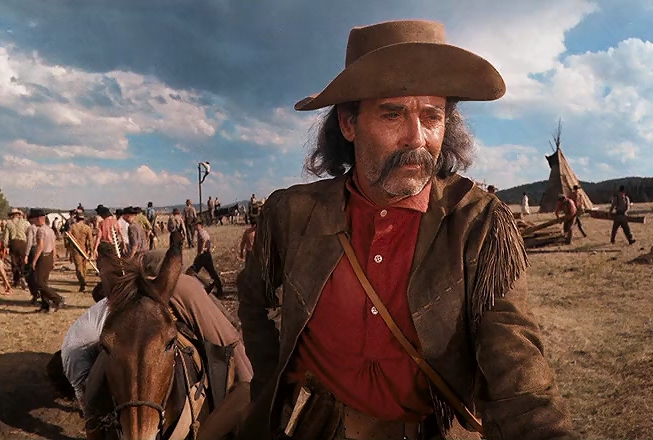
Frank first appears walking out of the desert with his henchmen before wiping out a family of three children and their father to the horror of contemporary audiences.
Fonda said that he didn’t realise what Leone was up to until he saw the finished movie and realised the director had cast him because “he could imagine the audience saying ‘Jesus Christ! It’s Henry Fonda!’”
The incongruity of an actor known for playing morally righteous characters such as Abraham Lincoln and Mister Roberts as a murderous swine bereft of any redeeming qualities whatsoever turns audience expectations well and truly on their head.
Fonda even gets to kick away the crutches from under a crippled railroad magnate, although what with the guy being a rich fat-cat with his own private train and too much money to spend he probably had it coming.
It eventually transpires via a flashback sequence that Frank had previous when it came to gratuitous acts of violence, in the process setting up what must be one of the most convoluted killings ever staged in a Western.
A few years before the main action takes place a younger Frank loops a noose around the neck of an older man who had presumably transgressed some unwritten law and then forced him to stand precariously on the shoulders of his much younger brother.
Frank shoves a harmonica into the mouth of the younger boy who eventually collapses, hanging his own brother in the process.
The boy grows up to be a stranger known as Harmonica (Charles Bronson), who tracks down Frank and announces his presence by playing some slow blues on the very harp Frank had gifted him years before.
Then he shoots him. It’s not really the kind of cinematic death Frank deserved to be honest, but I guess it would have taken a lot of screen time to have Harmonica do to Frank what Frank did to his brother.
The film was long enough as it was so I’m thinking that was a good call on Sergio’s part.
In the same year, Fonda also played another villain in another Western, “Firecreek”, released in early 1968. It’s not nearly half as beguiling as “Once Upon A Time in the West” but Fonda obviously needed to get all of his screen killing done as soon as possible before reverting to type in “Midway” and “On Golden Pond”.
Alex Nicol – “The Man from Laramie”
Nicol’s performance as resident mentally challenged Dave Waggoman, the deranged son of a powerful landowner, is so perfectly pitched you kind of wonder if the actor actually tortured small animals and insects whilst waiting for his turn in front of the camera.
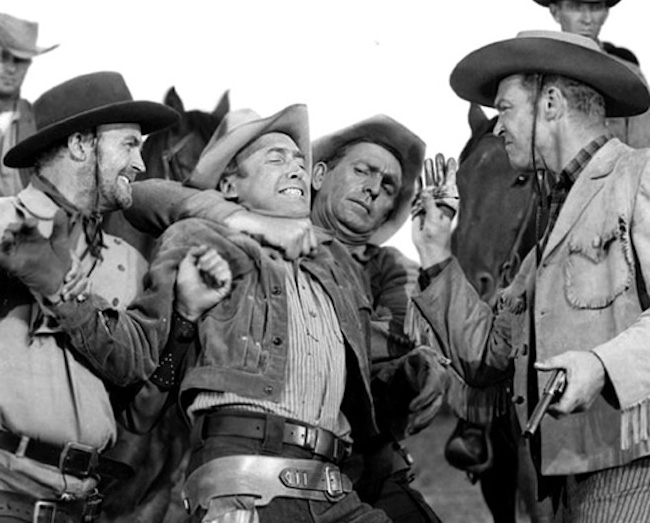
There’s no real explanation as to why Waggoman behaves the way he does but he is, without doubt, the most memorable of all of the villains that appear in the five Westerns James Stewart starred in for director Anthony Mann.
We first encounter Dave when Will Lockhart (James Stewart), working undercover to find the man responsible for the death of his younger brother, loads up his wagons with a cargo of salt located on Waggoman’s land.
Dave goes all Norman Bates on Lockhart and his companions by burning the wagons and shooting their mules. Lockhart is then roped and literally subjected to an ordeal by fire when he is dragged through the flames. Luckily Dave’s carer Vic (Arthur Kennedy) turns up and orders Dave to dial down on the violence.
In one of the best scenes in the movie, Lockhart comes across Dave back in town herding cattle into a corral and yanks his nemesis to the ground before proceeding to beat the living daylights out of him.
Lockhart is so wired that when Vic pulls him away from Dave, Lockhart is still so full of anger – you really do want him to rip Dave’s guts out (I did anyway) – that he lays into Vic as well, the rage etched on his face.
Later on, Mad Dave accuses Lockhart of stealing cattle, whereas he’s only separating his own stock from some strays.
A gunfight ensues and Lockhart hits Dave in the hand with a lucky shot. In an astoundingly brutal act of violence so outrageous you’re left open-jawed for a moment, Dave exacts revenge by ordering two of his men to hold Lockhart by the arms before shooting him point blank in the hand.
As a member of the audience, you really can’t wait until Dave gets his just deserts, although it’s not Lockhart who puts him out of his misery but Vic, who sold the rifles to the Apaches that resulted in the death of Lockhart’s brother.
I would have paid a lot of money to see Will Lockhart do for Dave himself though. Let’s be honest. Sometimes it’s best just to put a mad dog down. Therapy was never going to sort that boy out.
Gian Maria Volonte – “A Fistful of Dollars” / “For A Few Dollars More”
In the wonderful world of the Western there exists killer cowboys and the downright deranged – and then there’s Gian Maria Volonte who played back-to-back performances in the first two Dollar trilogy films as Ramon Rojo and then El Indio.
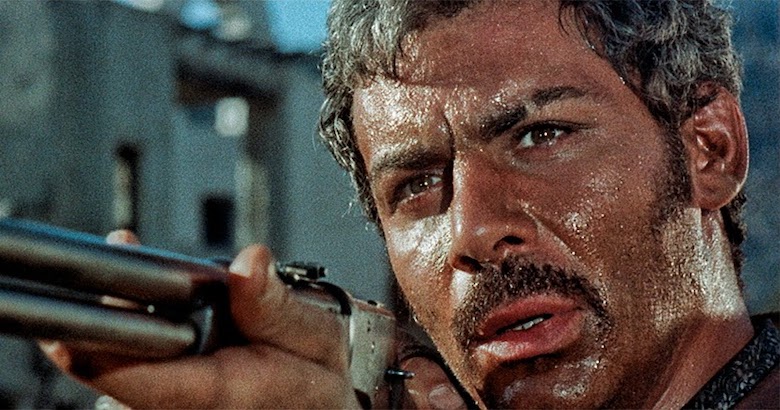
In “A Fistful of Dollars”, Volonte is almost a modicum of civility compared to the character he plays in “For A Few Dollars More”.
Okay, he does up the body count considerably by engaging in the massacre of a troop of soldiers when appropriating a cache of gold, kidnaps a woman and threatens to kill her husband and child unless she gives into his lascivious demands and then oversees another massacre, this time of a rival gang, before facing down the stranger known as Joe (Clint Eastwood).
Rojo is also a bit simple, continuously heeding Joe’s advice to shoot for the heart, Joe having tied a metal plate under his poncho to ward off the bullets, instead of blowing his head off as any other killer cowboy would do in the same situation.
This naturally leads to Rojo’s undoing, he and Joe engaging in a competition to see who can reload their weapon faster before Joe blows the poor sucker away.
When Volonte returned to take another shot at Clint in “For A Few Dollars More” as gang leader El Indio, it’s obvious the actor has decided to go full psycho, smoking dope to calm his nerves whilst reminiscing on the time he raped a young woman who subsequently killed herself after he shot her husband.
After murdering every guard he can find whilst breaking out of prison he tracks down the man who had him captured. He then forces his victim to listen whilst his wife and young child are taken outside and murdered to the accompaniment of a stolen timepiece – musical chimes courtesy of Ennio Morricone – before shooting the unfortunate husband dead.
This scene is genuinely chilling to watch and you’re just aching for the moment when Indio gets what he deserves, which he finally does at the end of this two-hour twelve-minute opus.
You think Indio is going to get the upper hand on bounty hunter Colonel Douglas Mortimer (Lee Van Cleef), who it turns out is the father of the woman Indio raped and killed. However, in a remarkable act of charity, fellow bounty hunter Manco (Clint Eastwood), gives Mortimer the opportunity to kill Indio himself.
The two men face off in another dance of the musical chimes, Mortimer despatching Indio with one well-aimed shot. Again, as with a number of the other characters mentioned so far, the villain is offed without too much fuss when what you really want to see is the swine suffer a long, slow lingering death.
Maybe that’s just me though.
Jack Palance – “Shane” (and too many others to list here)
Blessed with the face of a killer even if he wasn’t one in real life (I hope), Jack Palance’s unblinking eyes and penchant for just listening instead of talking makes his performance as gun-for-hire Jack Wilson in “Shane” one of the most memorable cowboy villains of all time.
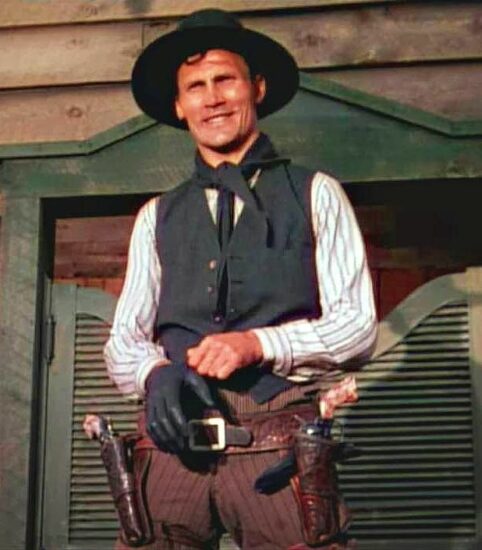
The actor, here credited as Walter Jack Palance, exudes menace from the moment he first appears, slowly riding his horse into town.
His first confrontation with Shane (Alan Ladd) is wordless, both protagonists eyeing each other up for what will be the inevitable confrontation.
Before that happens though we get to see Wilson pacing back and forth like a panther on the raised sidewalk outside the saloon, goading dirt farmer Stonewall Torrey (Elisha Cooke Jr.) into going for his gun then beating him to the draw (is there ever a film in which Cooke actually makes it through to the final reel in one piece?).
As an aside, the film breaks with Hollywood Western tradition by showing both killer and victim in the same frame.
Normally the convention is to cut back and forth between the protagonists before showing the killer firing his gun, then cutting to the victim as they react to being shot. It has been maintained that this cinematic taboo was first broken in the Clint Eastwood Spaghetti movie, “A Fistful of Dollars”. We suggest otherwise. Either way, poor old Stonewall ends up flat on his back in the mud.
Shane eventually turns up to rid the settlers of Wilson, confronting him in the saloon where all the bad guys live together.
Echoing the previous conversation between the doomed Stonewall and Wilson in which the gunfighter is referred to as a “lowdown Yankee liar”, Shane pulls the same stunt in an effort to unnerve Wilson with the following exchange:
[Shane] “I’ve heard about you”
[Wilson] “What have you heard, Shane?”
[Shane] “I’ve heard that you’re a low-down Yankee liar”
[Wilson]“Prove it”
Shane might be short but he’s still the fastest of the two, blowing Wilson away with one shot and sending the killer backward into a bunch of beer barrels, creating at the same time probably one of the most satisfying deaths in Western movie history.
Despite not sharing that much screen time in “Shane”, Palance’s performance earned him a nomination for Best Supporting Actor which was quite an achievement seeing as it was only his fourth big screen appearance.
Hollywood did what it does best and immediately cast Palance in yet another Western, “Arrowhead”, starring Charlton Heston and released the same year as “Shane”. Palance played an Apache who is so devoid of humanity, Chuck is forced to break his back in their climactic hand-to-hand fight at the end.
Thank you for reading our article on killer cowboys. I’m sure you’d agree there are so many more examples we could have listed which is why we’ll definitely be revisiting this subject at a later date.

You hit them all from Marvin to Hackman. I think that Hackman and Marvin were the worst. Where did Widmark fit in this group?